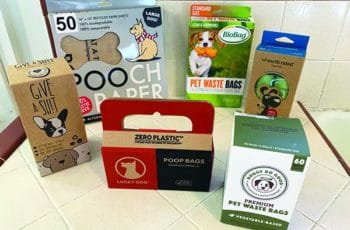by Janice A. Jones
Have you ever wondered just how to socialize a puppy?
Does it mean taking him or her to the dog park or introducing them to every neighbor, friend, or family member you have?
Maybe it means taking weeks off from work to acclimate your puppy to every possible sight, sound, taste, texture, and smell.
Actually no.
The process of how to socialize a puppy may actually be easier than you think.
Consider this.
Puppy Socialization
should start from birth but if you buy from a breeder or adopt, the chances are good that you will be getting your
dog at a much later time, mostly likely at the age of 8 to 12 weeks. What goes on from the time your puppy is born
until you get her makes a world of difference in how easy it will be for you to
train, but even more critical is how the dog will be as an adult.
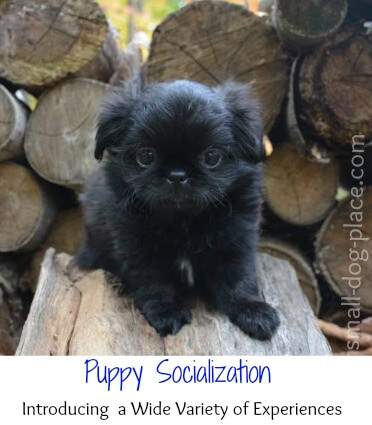 How to Socialize a Puppy
How to Socialize a PuppyGrisha Stewart, MA, CPDT-KA, from Ahimsa Dog
Training, in Seattle, WA and the author of A Practical, Force-Free Guide
to Problem
Solving and Manners suggests that very young puppies are just like
sponges soaking up new information at an incredible speed until they
reach 12 weeks of age.
From 12-16 they continue to learn quickly,
but not as fast as they did earlier.
When you think about it, puppies go from birth
where their only sense is smell and the instinct to seek warm and food, to a
young puppy that can run and play, learn commands, be potty trained, get along
with litter mates, and solve problems.
In three short months, they accomplish as much as the average child does
before entering kindergarten.
What speeds up this development? Smarter dogs may benefit from an early
enriched environment. This is nothing
new, but what is it that helps these puppies develop.
Margaret Huges is credited with creating the
Puppy’s Rule of Twelve. Adapting from
the earlier work, the rule of 7 by Pat
Schaap, a professional dog trainer who
maintained that by the age of 7 weeks, a puppy should be exposed to 7 different
surfaces, played with 7 different toys, been to 7 different locations and met 7
different people.
The rule of 7 also
goes on to propose that the puppy should
have 7 different experiences in a variety
of situation. For example, the puppy
should be exposed to 7 challenges, eaten from 7 different types of containers,
been fed in seven different locations, and so forth.
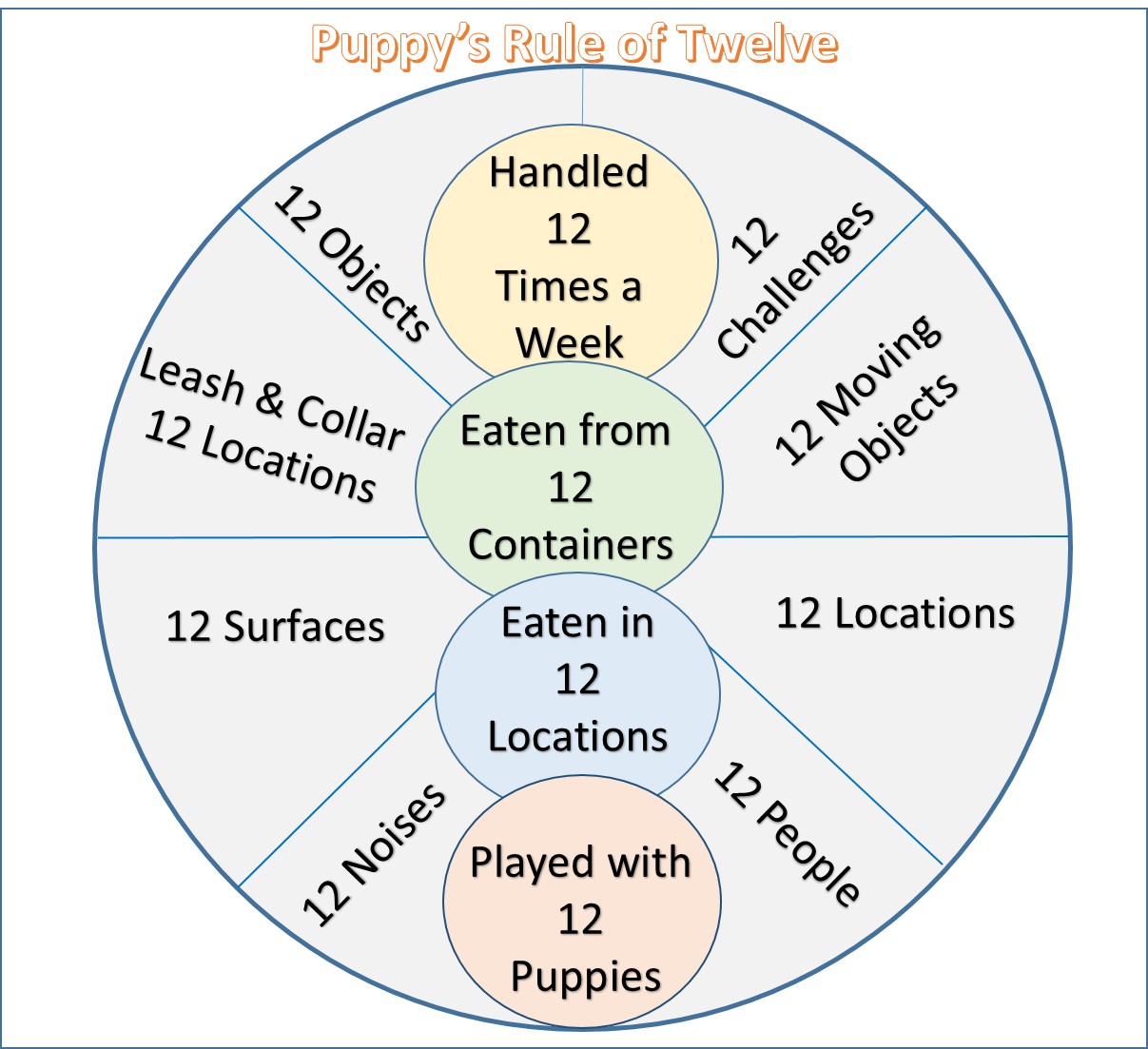 How to Socialize a Puppy: Rule of 12
How to Socialize a Puppy: Rule of 12The Puppy’s Rule of 12
which expands on the 7-week list to
include activities up through 12 weeks of age.
This presents a challenge for breeders who want to assure the puppies they are raising are well
socialized. What are these 12 activities?
How to Socialize a Puppy: Puppy’s Rule of Twelve
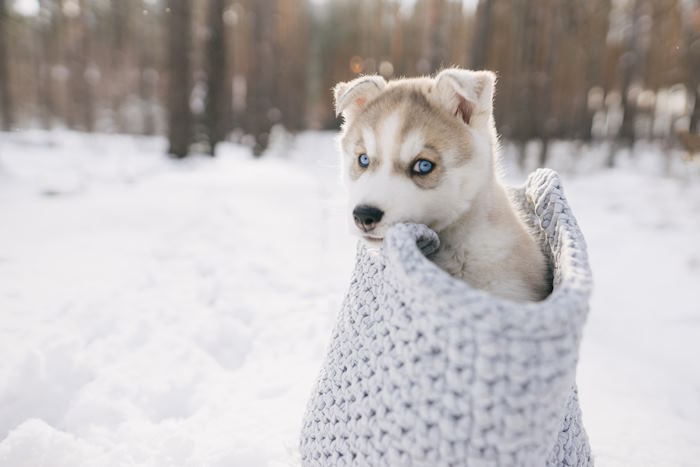
Experienced
12 different surfaces: wood, carpet, tile, cement, linoleum, grass, wet
grass, dirt, mud, puddles, deep pea gravel, grates, uneven surfaces, on a
table, on a chair, etc.
Played
with 12 different objects: fuzzy toys, big and small balls, hard toys,
funny sounding toys, wooden items, paper or cardboard items, milk jugs, metal
items, car keys, etc.
Experienced
12 different locations: front yard (daily), other people’s homes, schoolyard,
lake, pond, river, boat, basement, elevator, car, moving car, garage, laundry
room, kennel, veterinarian hospital (just to say hi and visit, lots of cookies,
no vaccinations), grooming salon (just to say hi), etc.
Met
and played with 12 new people (outside of family): include children,
adults (mostly men), elderly adults, people with wheelchairs, walkers, people with canes, crutches,
hats, sunglasses, etc.
Heard
to 12 different noises (garage door opening, doorbell, children playing,
babies screaming, big trucks, loud motorcycles, skateboards, washing machine,
shopping carts, power boat, clapping, loud singing, pan dropping, horses
neighing, vacuums, lawnmowers, birthday party, etc.
Been
exposed to 12 fast moving objects (don’t allow the puppy to chase):
skateboards, roller-skates, bicycles, motorcycles, cars, people running, cats
running, scooters, vacuums, children running, children playing soccer,
squirrels, cats, horses, cows, etc.
Experienced
12 different challenges: climb on, in, off, and around a box; go through
a cardboard tunnel; climb up and down steps; climb over obstacles; play hid and
seek; go in and out a doorway with a step up or down; exposed to an electric
sliding door; umbrella; balloons; walk on a wobbly table (plank of wood with a
small rock underneath); jump over a broom; climb over a log; bathtub (and
bath); etc.
Handled
by owner (and family) 12 times a week: hold underarm (like a football), hold to
chest, hold on floor near owner, hold in-between owner’s legs, hold head, look
in ears and mouth, touch in between toes, hold and take temperature (ask
veterinarian), hold like a baby, trim toenails, hold in lap, etc.
Eaten
from 12 different shaped containers: wobbly bowl, metal, cardboard box,
paper, coffee cup, china, pie plate, plastic, frying pan, Kong, treat ball,
spoon fed, paper bag, etc.
Eaten
in 12 different locations: backyard, front yard, crate, kitchen, basement, laundry room,
bathroom, friend’s house, car, schoolyard,
bathtub, up high (on the work bench),
under an umbrella, etc.
Played
with 12 different puppies (or safe adult dogs) as much as possible.
Been
left alone safely, away
from family and other animals (5-45 minutes) 12 times a week.
Experienced
a leash and collar 12 different times in 12 different locations
All the experiences
should be safe and positive and you
should have complete control to intervene
if need be.
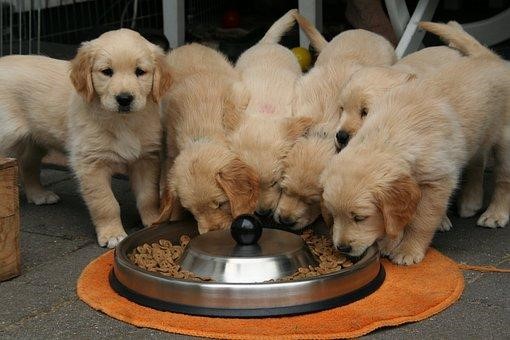
When I first learned
about these activities while reading Grisha Stewart ‘s book, I
had three thoughts about how to socialize a puppy:
- What if the puppy I’m buying hasn’t experienced
these things? - How can I be sure that new puppy will have these
experiences? - How does a breeder, even a good breeder have
enough time to do all these things?

What if
the puppy I’m buying hasn’t experienced Puppy’s Rule of 12?
A Puppy whose has not experienced the rule of 12
can still learn. Even if you get a puppy
after he has turned 12 weeks, don’t despair.
Like humans, a dog’s brain is very malleable in the early weeks of
life. This means that they can learn
very quickly.
With positive experiences, the puppy has a much
greater chance of developing into a well-adjusted adult. On the other hand, puppies and older dogs
continue to learn throughout their lifetime.
The sooner, the better, but it is
never too late.
How can
I be sure that new puppy will have these experiences?
You can always print out this list and post it
somewhere convenient. Try to provide
your dog with as many different experiences as possible without overdoing
it. Puppies need rest, relaxation and
sleep, so anything you do should be around those periods of sleep and eating.
Assuring that the Puppy has experiences with the
rule of 12 depends on who you have chosen for your new puppy’s breeder.
You will have more control of this if working
with a breeder than if you adopt from a shelter or rescue. Puppies
available for adoption may not even be relinquished by the time they turn 12
weeks. Remember also, that any puppies
available from such sources are not likely to have begun life in ideal
conditions.
If you are working with a breeder, you can always
ask if she/he has heard of Margaret Hughes’ Rule of 12. If not, give her the link to this page or
print it out and give it to them. If
they feel you are unreasonable, keep
reading.
How to Socialize a Puppy if You are a Breeder
How do
breeders accomplish all this socialization?
Before I could write this, I had to find out if
this were actually doable.
So, I took a
litter of 4 Shih Tzu puppies, two boys,
and two girls, and put them through the trials.
To make it harder, I did this in the dead of winter where at least 6
inches of snow on the ground is the norm in my location.
How to socialize a puppy, became how to socialize an entire litter. This was my challenge and this is what I was able to do:
12 Different Surfaces
We walked on carpet, ceramic
tile, wood, laminate, concrete, grass, dirt, leaf piles, snow, tables, sofa, and
a canvas bed (12)
12 Different Objects
Soft toys, rope toys, chews, hard plastic toys,
empty towel holders, wadded up paper, empty plastic water bottle, toys with
sound effects, tennis balls, small rags,
children’s plastic car, jack in the box. (12)
12 Different Locations
This was much harder for me. The puppies experienced: their own kennel area, our kitchen, hallway
and other rooms of the house, garage, veterinary hospital, car, moving car, front
yard, back deck, and driveway. (10)
12 New People
I was really worried that they wouldn’t have enough experience with enough people, but as it turned out, we did alright with this one: There were
five people in the family, two different friends visit, my veterinarian, the veterinary technician,
two vet receptionists, and the various puppy buyers that
came over. (12)
12 Different Sounds
This turned out to be the easiest one of all, thanks to the internet. The puppies heard dogs barking, hand clapping, door bell ringing, vacuum cleaner and rug shampooer, snow blower, garbage trucks, sirens, a person singing, a person playing the guitar and then, all the sounds available free on the internet.
Visit Sound Bible for Ideas
12 Fast Moving Objects
This was harder than it sounds, especially in the dead of winter. We were able to experience only five different fast moving objects: Cars, Trucks, People Running, Dogs chasing each other, and the cat running from dog. The new puppy owners will need to get creative with this one!
(This
task is likely easier in the warmer months when people are out and about more
frequently.
12 Different Challenges
(1) Finding the door to the whelping box and then climbing out. (2) Climbing off a raised bed, (3) Dealing with a bathtub (sink), (4) grooming table, (5) in and out of a
crate, (6) climbing on and off box, (7) Maneuvering a wobbly plank, (8) Introduction to step, but the
steps were as tall as the dogs. (9) Checking out an umbrella, (10) meeting up with balloons, (11) cardboard box tunnel
Handled 12 Times a Week
This one was easy. Who can resist picking up a small breed puppy and hugging, cuddling and carrying around with you?
- Held in different positions. (upright, on back, on stomach)
- Touched, tail, paws, ears, mouth, under eyes
- Clipped nails
- Combed and brushed hair
- Bathed, blow dry with a hairdryer
- Cut hair from paw pads
- Cleaned rear, did a sanitary clip
- Examined teeth, and ears
- Held on lap, table, in air, on the chest, in the a pocket, and cuddled in
the a towel - Took temperature
- Gave worming medication
- Gave vaccinations
- Measured weight gain on a scale
Eaten from 12 Containers
Stainless steel bowl, glass bowl, plastic
bowl, plastic plate, ceramic plate, medicine dropper, spoon, muffin tin, hand,
floor on a napkin, small fry pan
Eaten in 12 Different Locations
Played with 12 safe puppies or adult dogs
Played with litter mates and all my friendly adult dogs
Been left alone:
Stayed in crate with door open
Experienced a leash and
collar
No, still working on finding a collar and/or harness small enough to
fit the puppy. I will have to rely on
the new puppy owners to accomplish this task.
Did
I succeed with the 12 by 12?
As
you can see, many of my goals have been accomplished but not all. As of this writing, the puppies are seven
weeks old.
They will all go home by the
time they are 8 weeks old. Will they all
experience those 12 by 12?
The chances are good that the new owners will
be able to pick up where I left off, providing more experiences for their puppy
by the time they reach 12 weeks of age. If
I had not begun the process, the new
owners would have had much more work to do.
So,
was it easy to accomplish 12 by 12?
It
is not impossible and it is not even that challenging, but the trick is being
aware that it is important to offer different experiences to the puppy.
The Most Interesting Part of This Experience on how to socialize a puppy:
The puppies were so well behaved. I did not hear much barking or yelping to get out of the pen because they were bored. Rather, the puppies wanted back into their beds because the challenges tired them out and all they wanted to do was curl up and go to sleep.
Remember the Old Saying Among Dog Trainers:
A Tired Dog is a Good Dog…
May I suggest that a Challenged Puppy is a Good Puppy ?
Help With Socializing a Puppy
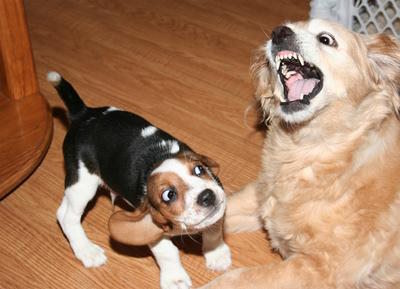
If you have another dog or cat in the household, socializating that new puppy just got easier. How, you ask?
Simple, by putting that established dog to work. Richard, from Sacramento, CA, USA explains how Cinnamon, his spaniel mix helped teach a few house rules to his new puppy.
Cinnamon and Max – House Rules…
by Richard
(Sacramento, CA USA)
Cinnamon, our Spaniel mix, of about 12 years, is explaining the House Rules to our new baby Beagle.
Max, the Beagle apparently crossed a line and is being read the riot act in this photo.
It was Max’s first day here.
Later they were inseparable.
Cinnamon never bit or went after anyone, or anybody in her 16-½ years with us. Though she looks a bit scary in the photo.
Our boy Max only made it 7 years with us, and cancer got him. WAY too soon.
Conclusion
Many
small dog lovers are so ecstatic to bring
home a new puppy that all they want to do is hold the dog and carry him
around.
While this is a good way to bond
with that new puppy, we need to realize that the puppy is an individual too and
needs as many new experiences as possible.
Provide those challenges and you’ll not only have a good puppy, but a well adjusted adult.
References and Further Reading For those Interested in How to Socialize a Puppy
For
more information on Rising Puppies (and adult dogs) may I suggest some of my favorite books. These books cover socialization, training, and puppy behavior and are a great resource for anyone with a puppy or who are thinking about getting a puppy.
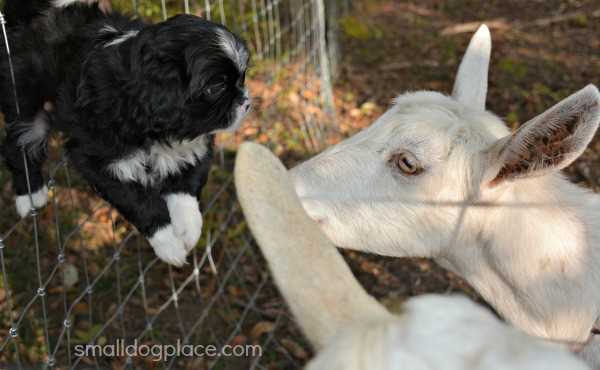
About Janice (author and voice behind this site)
Having lived with dogs and cats most of her life, Janice served as a veterinary technician for ten years in Maryland and twelve years as a Shih Tzu dog breeder in Ohio.
Her education includes undergraduate degrees in Psychology with a minor in biology, Early Childhood Education, and Nursing, and a master’s in Mental Health Counseling.
She is a lifelong learner, a dog lover, and passionate about the welfare of animals. Her favorite breed for over 50 years has been the Shih Tzu, but she has also lived with Poodles, Maltese, Yorkshire Terriers, Beagles, English Bulldogs, Carin Terriers, and a Cocker Spaniel.
When not writing, reading, and researching dog-related topics, she likes to spend time with her eight Shih Tzu dogs, husband, and family, as well as knitting and crocheting. She is also the voice behind Miracle Shih Tzu and Smart-Knit-Crocheting
Does This Article Deserve Your Thumbs Up?
We always appreciate your support and encouragement. Your thumbs up means so much to us. Please like this article.
If you find this page or any page on Small Dog Place Helpful, or useful in anyway, I’d love it if you would click the small heart found on the bottom right of each page.
You can also share or bookmark this page — just click on the:

Free Monthly Newsletter
Sign Up for Our Free Newsletter and get our Free Gift to You.
my E-book, The Top 10 Mistakes People Make When Choosing a Dog (and how to avoid them)


